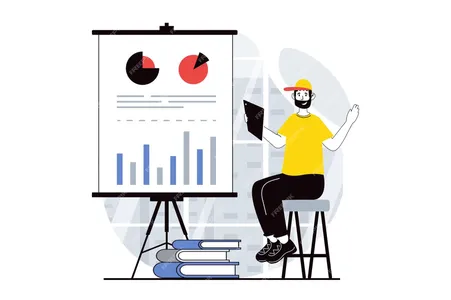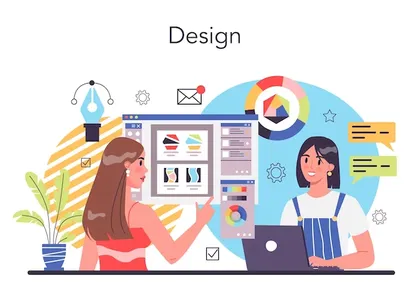Introduction
As HBr says: “While a good presentation has data, data alone does not guarantee a good presentation.” In the age of PowerPoint and Canva, where presenting information has become easier than ever, raise your hand if you’ve never heard a presenter say, “This diagram may be hard to see, but it illustrates…” What could be worse? than a presentation that struggles to convey its essence?
Every working professional knows the important efforts involved in improving and perfecting tasks. For example, as a data analyst, you work very hard to add perfection to your data analysis, stay up-to-date on technology trends, and build machine learning models. However, an essential skill that is often overlooked is the ability to craft engaging presentations. To showcase all your hard work and efforts clearly and efficiently to your audience, you need to improve your presentation so that it engages your audience well and promotes informed decision making.
The power of an effective presentation
A presentation involves visually representing information through tables, graphs, maps and various techniques, improving understanding through visual aids. This graphical representation, called data visualization, depends on factors such as the format, tools, available data, and size of the data set.
When creating a presentation, consider essential factors such as target audience, clear content, required graphs, tables and charts, easy-to-understand information and clear explanations. The power of an effective presentation cannot be overlooked, as it showcases your efforts and helps you drive change in your organization.
7 tips to make a super attractive presentation
There are several key points you should consider when creating an effective presentation. However, listed below are seven important tips to improve your presentation and make it super attractive:
1. Know your audience
Instead of solely emphasizing the findings, you should prioritize tailoring your presentation to the audience. Understanding their background and what they are looking for from their findings helps frame the presentation effectively.
This approach does not ignore the data; rather, it involves presenting it in a way that is easily understandable and supports the audience’s familiar discussions or arguments. Even the most exceptional presentations could fail if the audience has difficulty following the analyst’s method of conveying his or her findings.
You can improve your presentation by considering the following questions before creating it:
- Who makes up the audience for this presentation?
- What level of technical competence do they have in their field?
- How familiar are they with the topic?
- What specific interests, needs and expectations do they have?
- What is the mental state of the audience? Are they tired from previous meetings or a long conference?
- Is the environment formal or informal?
By addressing these queries, you’ll gain clarity on what information needs emphasis and how your data can best serve the presentation. Tailoring content to fit the audience’s experience, defining desired takeaways, and considering the presentation environment will lead to a more impactful presentation.
2. Tell stories with data
In business presentations, an approach known as Situation-Complication-Resolution (SCR) acts as a structured framework and helps improve your presentation. This method was popularized by Barbara Minto in her book “The Pyramid Principle” during her tenure at McKinsey Consulting, providing an effective structure for building a compelling business story. Its simplicity helps foster action-oriented results, organize content, and align with the Rule of Three, a principle I’ll explain later.
- Present factual information that represents the current situation.
- Identify the need for action derived from the evaluation of the situation.
- Propose or execute viable measures to address and resolve the identified complication.
In practical application, additional details would be incorporated as sub-elements below each node. The use of SCR facilitates the development of a clear and attractive narrative.
3. Simplify complex concepts
It’s natural to feel excited when preparing a presentation, especially when you’re proud of your work and find much of the content important. However, overwhelming your audience with information can diminish the impact of our efforts. The essence of effectively conveying findings lies in keeping the presentation simple. Here are some tips to ensure conciseness and clarity in your images:
Ensure visual clarity by avoiding cluttering it with numerous information and images. Use colors strategically to accentuate different data points while maintaining a consistent text style and color scheme throughout your presentation.
In terms of written content, prioritize inclusivity and use language that is accessible and relevant to your audience. Emphasize key words or critical findings by bolding or highlighting them. Simplifying your presentation helps your audience understand your argument and key takeaways. Complexity is not necessary to convey your message effectively.
4. Interact with images
Consider your audience’s familiarity with data representation tools when you plan to enhance your presentation through visual design. Use pie charts to illustrate demographic breakdowns, bar charts for trend analysis across different years, and flowcharts to visually connect process components.

Opting for these familiar data representation formats enhances the visual appeal of your presentation and ensures effective communication with your audience through easily understandable images.
Recognize your presentation and ask yourself:
- Is data correctly labeled and annotated in visuals?
- Are there clear titles, axis labels, legends, and units of measurement?
- Are colors used in ways that clarify my findings?
- Are the slides organized and the data presented impeccably?
- Are all images presented with the goal of communicating a specific finding to my audience?
Asking yourself these questions will strengthen your presentation and help your audience leave with a clear understanding of your data-driven proposal.
5. Practice makes perfect
Whenever you create a presentation that presents your data, be sure to make some small improvements wherever possible. Plus, get ideas on how to make your presentation more engaging, engaging, informative and effective. Therefore, with every presentation you give, you will improve your presentation with perfection and clarity.
6. Interactive and attractive presentations
Use techniques like pre-attention attributes to focus attention on key phrases or words beyond just single words or numbers on a slide, thus enhancing their impact. These attributes include the use of italics, bold, different colors or sizes to highlight certain elements, capturing the audience’s attention in the first fraction of a second. An integral aspect of your presentation involves justifying to your audience why they should invest.
Integrating real-world examples allows your audience to engage, empathize, and relate to the importance of your work. Incorporating case studies or examples that resonate with them facilitates engagement and makes a practical connection between the data in your presentation and their everyday experiences.
Improve your presentation according to the audience:
- For company presentations, align your content with your values, values, and mission, emphasizing how your proposal benefits your specific organization.
- When introducing your colleagues, emphasize the connections between your work and theirs. Consider talking to them beforehand to better highlight these connections during your presentation.
When addressing a broader audience, stay up to date on broader topics, industry trends, and current events that intersect with your work. Integrate these examples into your presentation to underline the relevance of your work.
Your goal is to bridge the gap between your work and the audience’s interests. Engage them by linking your content to their work or daily life, as finding this connection often serves as a crucial step toward audience engagement.
<h3 class="wp-block-heading" id="h-7-utilize-technology-tools”>7. Use technological tools
Integrating technology can improve the engagement and interactivity of your presentation. Use tools to share resources, conduct surveys, solicit feedback, and encourage interaction. Platforms such as Mentimeter, Google Forms or Kahoot allow the display of interactive questionnaires, word clouds or surveys. Communication via social media, email, or chat before, during, or after the presentation also contributes to engagement.

However, it is important to be aware of the potential challenges and distractions that technology can present. Avoid multitasking, such as checking your phone or reading directly from the slides during the presentation. Actively monitor online interactions and quickly address technical issues or audience queries to maintain a seamless experience.
Conclusion
Presenting your data effectively is crucial to communicating your findings to colleagues, clients, or potential investors. Despite possessing strong technical skills, the inability to present these conclusions to the relevant audience can undermine your efforts. A well-crafted presentation not only conveys confidence in your findings but also reflects pride in the work performed.
 NEWSLETTER
NEWSLETTER





